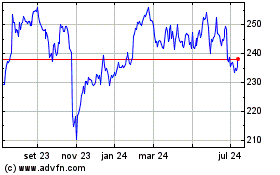Nonfarm Payrolls Disappoint Again - Analyst Blog
06 Julho 2012 - 6:25AM
Zacks
The U.S. labor market remains front and center today following
another disappointing monthly jobs report this morning. Thursday’s
report from Automatic Data Processing (ADP) had
raised hopes that we would break the negative cycle of back-to-back
disappointing jobs numbers of the last three months. But it was not
to be, as this seems to be the new norm on the labor market
front.
There is no doubt now that the brief spurt of labor market momentum
during the winter months is now firmly behind us. Economists will
debate the causes of the economic slowdown this Spring, but the
trend is quite clear. Monthly job gains averaged 75K in the second
quarter, down sharply from first quarter’s monthly pace of
226K.
The question at this stage is whether these jobs numbers are bad
enough to prompt a fresh response from the Fed. I thought a number
around 50K today would qualify for that type of response, but
today’s number is not much better. But irrespective of what the Fed
does or does not do, these numbers are not good enough to produce a
meaningful improvement in household buying power.
The Bureau of Labor Statistics (BLS) reported June non-farm payroll
gains of 80K, below the roughly 100K expected and the 77K jobs in
May (revised higher from 69K originally reported). The revisions
trend was mixed, with May revised higher and April revised lower.
For context, keep in mind that monthly job gains totaled 84K in
June 2011. The unemployment and the labor force participation rates
remained unchanged at 8.2% and 63.8%, respectively.
Thursday’s ADP report of strong private sector job gains seems like
a distant memory now as we can’t see any of those jobs in today’s
BLS report. A total 84K private sector jobs were created in June,
with the government sector suffering job losses of 4K. This
compares to private sector jobs of 105K in the month before and
102K in June 2011.
Manufacturing added 11K jobs in June, compared to 9K in May and 10K
in April. Service sector jobs totaled 71K, down from 126K in May
and 81K in April. Temp jobs increased, up 25.2K in June from 18.6K
in May. The average workweek edged by 0.1 hours to 34.5 hours,
while average hourly earnings increased by 6 cents to $23.50. The
June average hourly earnings are up 2% from the same period last
year.
Either way you slice it, today’s report doesn’t paint an inspiring
picture of the U.S. economy. It isn’t so much the difference
between the 80K jobs reported this morning and the expectation of
about 100K, but the fact that we are witnessing another slowdown in
the economy.
The only positive one could take away from this report is that the
labor market recovery is still underway; it may be slow, halting
and underwhelming, but the economy is nevertheless producing jobs
and not shedding them. Given the unfavorable global backdrop, with
Europe in recession and China slowing down, that has to count for
something.
AUTOMATIC DATA (ADP): Free Stock Analysis Report
To read this article on Zacks.com click here.
Zacks Investment Research
Automatic Data Processing (NASDAQ:ADP)
Gráfico Histórico do Ativo
De Jun 2024 até Jul 2024

Automatic Data Processing (NASDAQ:ADP)
Gráfico Histórico do Ativo
De Jul 2023 até Jul 2024
